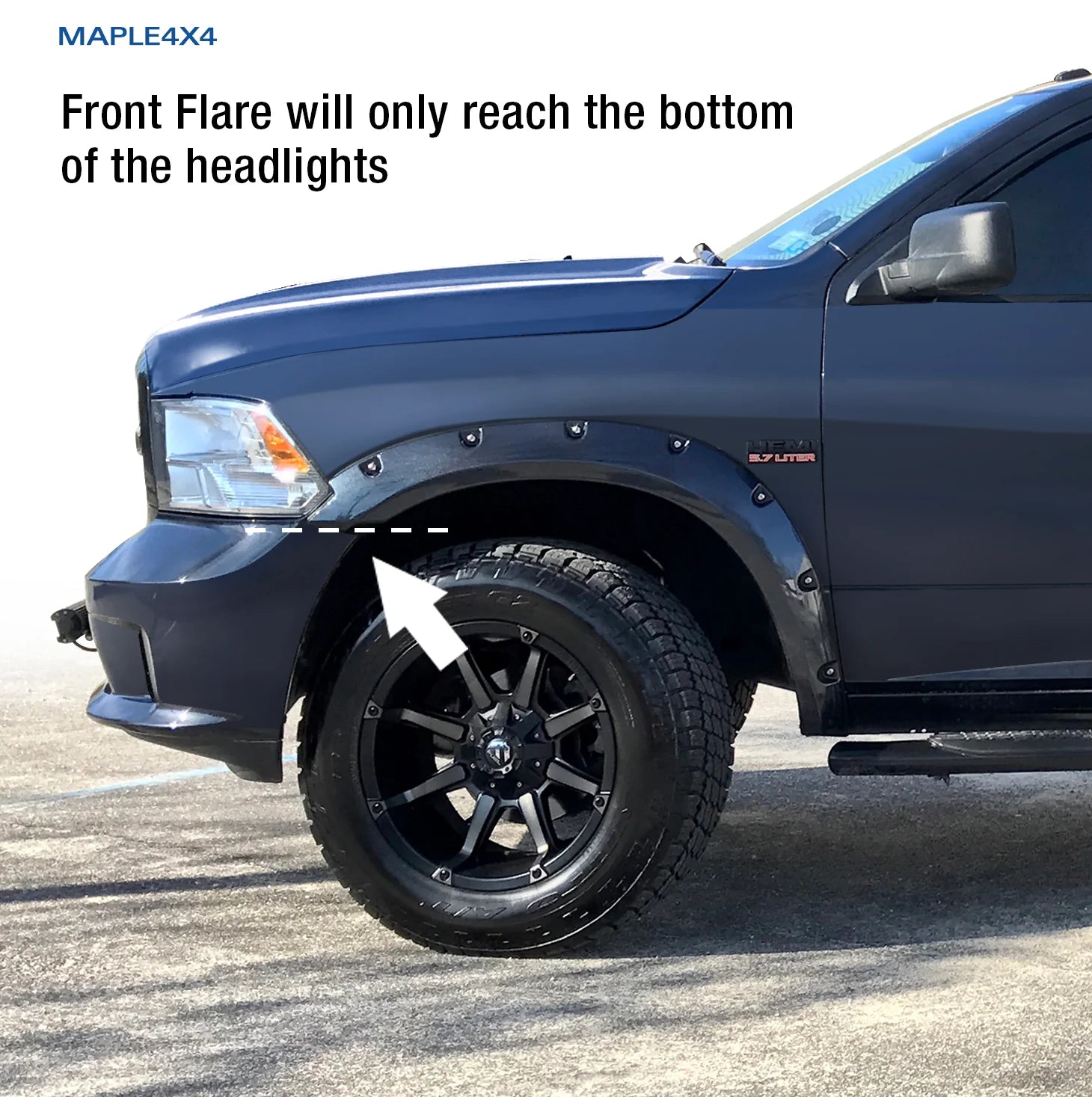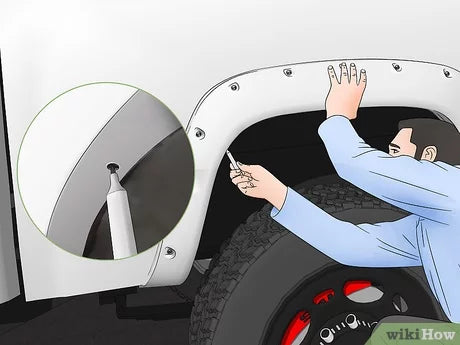The Ultimate Guide to Choose Fender flares are an essential accessory for any 4x4 enthusiast looking to enhance both the appearance and functionality of their vehicle. These stylish additions not only provide a rugged and aggressive look but also serve a practical purpose by protecting your vehicle's paintwork from debris, mud, and rocks. If you're considering installing fender flares on your 4x4, this comprehensive guide will walk you through the different types available, factors to consider, and offer practical tips to help you make the right choice.
What are fender flares?
They are made from materials such as ABS plastic, fiberglass, or metal.
They come in various styles and sizes to suit different vehicle models.
Benefits of installing fender flares
The Ultimate Guide of Installing fender flares offers several benefits for 4x4 owners. Firstly, they provide added protection to your vehicle's bodywork, shielding it from rocks, mud, and other road debris that can cause scratches or dents. Additionally, fender flares help prevent rust and corrosion by reducing the exposure of your vehicle's vulnerable areas to moisture and dirt.
Moreover, fender flares can accommodate larger tires and wheels, allowing you to upgrade your 4x4's off-road capabilities. They also enhance the aesthetics of your vehicle, giving it a more aggressive and customized look. Lastly, fender flares can increase the resale value of your 4x4 by protecting its original paint and bodywork.
The Ultimate Guide of Types of fender flares
There are several types of fender flares available in the market, each offering unique features and benefits. Understanding the different types will help you make an informed decision based on your preferences and requirements. The most common types of fender flares include:
Bolt-on fender flares
Bolt-on fender flares are a popular choice for off-road enthusiasts. As the name suggests, these flares require drilling and bolting onto the vehicle's fenders. They provide a secure and permanent attachment and are known for their durability and strength.
Cut-out fender flares
The Ultimate Guide to Cut-out fender flares are designed for those who prefer a more customized and aggressive look. These flares require cutting out a portion of the original fender before installation, allowing for a wider wheel well opening. Cut-out fender flares are typically made from durable materials and offer excellent tire clearance.
Extended fender flares
The Ultimate Guide to Extended fender flares are wider and offer maximum coverage compared to other types. They provide additional protection from road debris and are a popular choice for off-roaders who frequently encounter muddy or rocky terrains. Extended fender flares are available in various styles and materials to suit different vehicle models.
Pocket-style fender flares
The Ultimate Guide to Pocket-style fender flares are characterized by their distinctive pocketed design. They offer a rugged and bold appearance and are a favorite among truck and Jeep owners. Pocket-style fender flares are usually made from durable ABS plastic and are easy to install without any drilling or cutting required.
Factors to consider when choosing fender flares
When selecting fender flares for your 4x4, there are several important factors to consider. Taking these factors into account will help you choose the right flares that best fit your vehicle and meet your specific needs.
Vehicle compatibility
Before purchasing fender flares, ensure that they are compatible with your specific make and model of 4x4. Different vehicles have varying fender shapes and sizes, so it's important to select flares that are designed to fit your vehicle perfectly.
Material and durability
Consider the material used in the construction of the fender flares. ABS plastic flares are lightweight, affordable, and resistant to impacts and weathering. Fiberglass flares offer better strength and flexibility, making them suitable for more rugged off-road applications. Metal flares, such as those made from aluminum or steel, are highly durable but tend to be heavier and more expensive.
Style and appearance
Choose a fender flare style that matches your personal taste and complements the overall look of your 4x4. Whether you prefer a sleek and subtle design or a bold and aggressive appearance, there are various options available to suit your preferences.
Coverage and tire size
Consider the level of coverage you require. If you often drive through muddy or rocky terrains, you may opt for wider fender flares that offer increased protection. Additionally, ensure that the flares provide sufficient clearance for your chosen tire size, especially if you plan to install larger wheels and tires.
Installation requirements
Evaluate the installation process of the fender flares. Some flares may require professional installation, while others can be easily installed as a DIY project. Consider your skill level and the tools required before making a decision.
Determining the right size of fender flares
Determining the correct size of fender flares for your 4x4 is crucial to ensure a proper fit and optimal functionality. Measure the distance between the edge of your vehicle's wheel well and the outermost point of your tire to determine the width of the fender flares needed. It's important to choose flares that provide adequate coverage without interfering with the tire's movement.
Popular fender flare brands in the market
The market offers a wide range of fender flare brands, each with its own reputation for quality and performance. Some popular brands include Bushwacker, EGR, Smittybilt, Rugged Ridge, and Lund. Researching customer reviews and seeking recommendations from fellow 4x4 enthusiasts can help you narrow down your choices and find a brand that meets your expectations.
Step-by-step guide to installing fender flares
Installing fender flares can be a rewarding DIY project if you have the necessary tools and follow the correct steps. Here's a general guide to help you with the installation process:
Step 1: Gather the necessary tools and materials
Before starting the installation, make sure you have all the required tools and materials on hand. This may include a drill, screws, a screwdriver, masking tape, and the fender flares themselves.
Step 2: Prepare the vehicle
Clean the surface around the wheel wells thoroughly to ensure proper adhesion of the fender flares. Use masking tape to mark the areas where the flares will be attached.
Step 3: Test-fit the flares
Hold the fender flares against the wheel wells to ensure they fit properly and align correctly. Make any necessary adjustments before proceeding.
Step 4: Drill and attach the flares
Follow the manufacturer's instructions for drilling holes and attaching the fender flares securely. Use the provided screws or bolts to fasten the flares in place.
Step 5: Check for alignment and tightness
Double-check the alignment of the fender flares and ensure they are securely fastened. Make any final adjustments if needed.
Step 6: Repeat for other wheel wells
Repeat the same steps for the remaining wheel wells, installing fender flares on each side of the vehicle.
Step 7: Clean and finish
Clean the fender flares and the surrounding area, removing any fingerprints or dirt. Apply a protective coating or wax to enhance their appearance and longevity.
Maintenance and care tips for fender flares
To ensure your fender flares stay in optimal condition and continue to enhance the look of your 4x4, here are some maintenance and care tips to follow:
- Regularly clean the fender flares using mild soap and water. Avoid using harsh chemicals or abrasive cleaners that can damage the finish.
- Inspect the flares for any signs of damage or loose attachments. Tighten any screws or bolts as needed.
- Apply a UV protectant to prevent fading and cracking caused by prolonged sun exposure.
- Remove any mud, dirt, or debris that accumulates on the flares, as it can lead to scratches or damage over time.
- Avoid hitting the fender flares against hard objects or obstacles, as this can cause them to break or become misaligned.
Frequently Asked Questions (FAQs)
Can I install fender flares myself?
Yes, many fender flares are designed for easy installation as a DIY project. However, some may require professional installation if they involve drilling or cutting into the vehicle's bodywork.
Are fender flares legal?
Fender flare regulations vary by jurisdiction. It's important to check your local laws and regulations regarding fender flare requirements, especially if you plan to use your 4x4 on public roads.
Do fender flares affect vehicle aerodynamics?
Fender flares can potentially alter the aerodynamics of your vehicle, especially if they are wider or have a protruding design. However, the impact on aerodynamics is generally minimal and should not significantly affect your vehicle's performance.
Can fender flares prevent rust and corrosion?
Fender flares provide additional protection to vulnerable areas of your vehicle's bodywork, reducing the exposure to moisture and dirt. However, proper cleaning and maintenance are still necessary to prevent rust and corrosion.
How often should I clean and maintain my fender flares?
It's recommended to clean your fender flares regularly, especially after off-road adventures or exposure to mud and debris. Additionally, inspect them periodically for any signs of damage or loose


